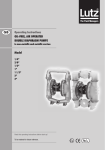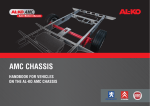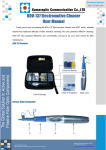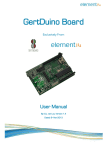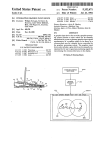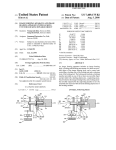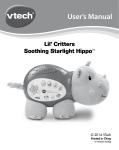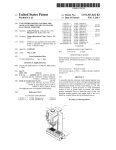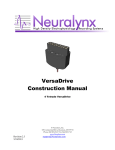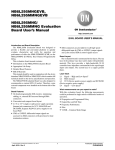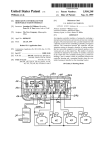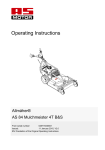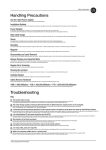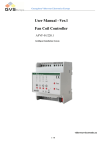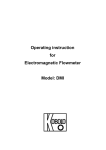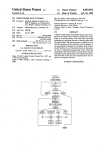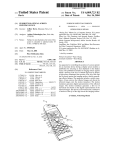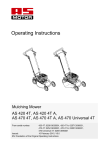Download Programmer/timer with combined line and program function switch
Transcript
United States Patent [191 [11] Patent Number: 4,892,983 Bogda et a1. [45] Date of Patent: Jan. 9, 1990 [54] PROGRAMMER/TIMER WITH COMBINED LINE AND PROGRAM FUNCTION SWITCH [75] Inventors: Richard C. Bogda, Elmhurst; George D. Georgacakis, Skokie, both of Ill. Primary Examiner-J, R. Scott Attorney, Agent, or Firm—-R. A. Johnston [57] ABSTRACT A combination programmer and line switch for an ap Eaton Corporation, Cleveland, Ohio [21] Appl. No.: 281,572 Dec. 8, 1988 [22] Filed: motor connected for advancing the cam. An upper line power contact blade is moved between high and low positions by a manual actuator. A lower contact blade is [51] Int. 01.4 [52] US. Cl. H01H 43/00 200/38 R; 200/38 A; maintained stationary and is adapted for connection to certain appliance load functions. An intermediate pro 200/ 38 B; 200/38 C 200/38 R, 38 A, 38 F, gram contact blade series connected to the timing motor has a follower biased against the program cam 200/38 FA, 38 PB, 38 B, 33 BA, 38 C, 38 CA and is adapted for connection to all appliance functions. [73] Assignee: [58] Field of Search [56] References Cited pliance having a rotary program cam and a timing with-the upper contact the high position, the motor circuit is open for all positions of the program and in the us’ PATENT DOCUMENTS 3,431,372 4/1969 Obermann low position the timing motor is energized. Alterna . tively, the program cam may include a line contact 3,752,944 2/1975 3,866,002 8/1973 Underwood Cartier etal. etal switch override to maintain the intermedaite blade in contact with the upper blade for both positions of the 4,413,16411/1983 4,497,985 2/1985 manual actuator. Obermann et a1. . Courter m1. .. 4,497,986 2/1985 Zink etal 4,560,846 12/1985 Klopp et al. .. 7 Claims, 4 Drawing Sheets US. Patent Jan. 9, 1990 Sheet 1 of4 4,892,983 US. Patent Jan. 9, 1990 Sheet 4 of4 4,892,983 1 ‘4,892,983 2 cam operated program switch in a programmer/timer PROGRAMMER/TIMER WITH COMBINED LINE - AND PROGRAM FUNCI‘ION SWITCH BACKGROUND OF THE INVENTION The present invention relates to electrical program mer/timers for appliances and particularly for house hold appliances such as washing machines, dishwashers and clothes dryers having user selected program inter vals. Appliances of this type typically have a knob or dial rotated by the user for selection of the length of the having rotary cam drum for actuating program function switches and to maintain power to the timing motor for certain positions of the program cam drum when the 5 line switch is manually opened with the cam drum in such position. SUMMARY OF THE INVENTION The present invention provides a programmer/timer for an appliance such as household dishwashers, wash ing machines and clothes dryers and has a rotary pro gram cam drum with a plurality of cam followers dis appliance service program. The user rotates the dial to the selected dial position or mark for positioning a rotat able program cam operative to be advanced or rotated by a suitable timing mechanism such as a motorized chine function switch in a prescribed sequence as the cam drum is advanced by rotary movement. The cam speed reducer or periodically advanced pawl driving a advancement is provided by a synchronous timing toothed ratchet connected to the program cam and motor connected via a speed reducer mechanism for indexing the cam with each stroke of the pawl for time driving an oscillating pawl which indexes the ratchet posed thereabout each operative for actuating a ma out of the selected program interval. The program cam wheel connected to the program cam drum. is typically contacted by a plurality of cam followers 0 A line power and program function switch has a positioned thereabout for providing a desired sequence user-actuated axially moved cam member for contact of operation to electrical function switches connected to each of the cam followers. The switches typically provide for the desired individual appliance functions such as controlling an electric water inlet valve, a water drain pump or drain valve, or an agitation and spin motor. Programmer/timers of the above-described type are typically driven by a small subfractional horsepower synchronous timing motor which is connected to the appliance power line connector via a line switch. In some household appliance designs, it has been desired to provide actuation of the appliance line power switch by providing an axial movement to the program knob or dial for actuation of the line switch. Where space is at a ing a slider member which is moved radially for actuat ing an upper line power switch contact blade which is disposed as the uppermost blade in a stack of at least three blades. A program switch contact blade which is the lowest of the stack has a stationary position and is adapted for electrical connection to certain machine functions. An intermediate switch contact blade has a cam follower provided thereon and is moved in re sponse to the program cam for making and breaking a circuit with the upper line contact blade when a line switch actuator cam member is axially moved between the “ON” position and the “OFF” position. The inter mediate contact blade is operative to make and break a premium for packaging the programmer/timer in the appliance control panel housing, the size of the program circuit connection with the lower program blade only thereby. It has therefore been desired to integrate the line function switch with the switches actuated by the contact blade to maintain line power to the timing ' in response to movement of the program cam. When the line switch actuator cam is positioned to the “ON” cam drum is limited, which in turn limits the number position, the upper contact blade moves downward and size of cam actuated function or program switches that can be disposed about the cam drum for actuation 40 under self-bias to make contact with the intermediate motor and certain machine program functions for all positions of the program cam. In an alternative embodi program cam followers to conserve space and reduce ment, the program cam is provided with suf?cient lift in manufacturing cost. Where the appliance line power switch is combined 45 certain positions to maintain the intermediate contact blade against the line power contact blade when the line with cam actuated switching functions, it has been switch actuator is in the “OFF” position, for maintain found difficult to provide for separate user-actuation of ing power to the timing motor for said certain positions the line power switch to retain user control of the appli of the program cam to provide continued timing motor ance, and yet also provide for continuing power to the operation for resetting the cam when the line power timing motor for advancing the cam to a desired posi switch is opened by the appliance user to prevent subse tion for restart after all other appliance functions have quent restart with the cam in an undesired position. been disconnected by the power line switch. The present invention thus provides a low cost com It is known to provide an appliance programmer/ pact programmer/timer for a household appliance and timer having a rotary program cam for actuating a employs a rotary program cam with a line power switch plurality of function switches wherein the line switch is combined with one of the program switches to provide combined with a program switch and the line switch is for maintaining power to the cam advance motor when actuated by axial movement of the knob shaft for mov the program switches are open. The present invention ing a slider to actuate the line switch. An example of thus provides for line switch and program function such is described in US. Pat. No. 3,431,372 in the name of G. Obermann and in US. Pat. No. 4,497,985 in the 60 switching in a single combined switch start actuated by a single cam track. In the present invention the user also name of Courter etal. However, the aforementioned. programmer/timers having a combined program and provides line switch actuation by axial movement of a line function switch do not provide for maintaining line switch actuator cam connected to the rotary selec power to the timing motor irrespective of the position tor knob. Alternatively, axial movement of the line of the line switch actuator for certain positions of the 65 switch actuator cam may be affected by an auxilliary program cam. cam which follows a stationery projection when the Thus, it has been desired to find a way or means of program cam is rotated to a certain position by the providing an appliance line switch combined with a advance mechanism. 3 4,892,983 4 manner well known in the art, the details of which have BRIEF DESCRIPTION OF THE DRAWINGS been omitted for the sake of brevity. Deck plate 12 has mounted thereon an insulator block - FIG. 1 is a somewhat perspective of the program 32 which has molded therein and extending outwardly thereform in spaced generally parallel cantilevered rela mer/timer of the present invention with portions of the housing removed; tionship a plurality of stacked switch contact blades comprising a combination line and program switch assembly indicated generally at 34. The combination FIG. 2 is an enlarged view of a portion of the line switch actuator of FIG. 1; FIG. 3 is a front view of the combined line/program switch of FIG. 1 with the line switch actuator in the “OFF” position and the switches in the open circuit switch has an upper contact blade 36 which extends the furthest distance from block 32 and which has a termi nal portion 38 extending through the block 32 and out wardly therefrom for electrical connection to one side of a power line. The line switch contact blade 36 has condition; FIG. 4 is a view similar to FIG. 3 with the line switch actuator in the “ON” position, the line switch closed and the program switch open circuit; provided on the lower face thereof a suitable button contact 40 which is adapted for making and breaking a FIG. 5 is a view similar to FIG. 4 with the program cam rotated to a position closing the program switch; FIG. 6 is a view similar to FIG. 3 and shows the line cent the lower face of the line switch contact blade 36 switch actuator in the “OFF” position with the pro near its free end is a line switch actuator 42 which is gram maintaining the line switch closed; suitably mounted on deck plate 12 for sliding movement circuit upon movement of the blade 36. Disposed adja FIG. 7 is a view similar to FIG. 6 with the line switch 20 in the vertical direction. Line switch actuator 42 has an actuator in the “ON” position and the cam maintaining inclined “cam surface 44 provided thereon which contacts a corresponding surface 48 provided on an the line switch closed; FIG. 8 is a view similar to FIG. 7 with the line switch axially movable cam member 46. Cam member 46 has a actuator in the “ON” position and the cam rotated to a shaft extending therefrom which is received in cam 14 position closing the program switch; 25 for axially sliding movement therein by the appliance FIG. 9 is a view similar to FIG. 8 with the program cam in the same position as FIG. 8 but with the line user. Axial movement of cam member 46 is effective to cause movement of line switch actuator 42 from the switch actuator in the “OFF” position opening the line position shown in solid outline in FIG. 2 to the position shown in dashed outline. It will be understood that shaft 49 although axially moveable is engaged with cam drum switch; FIG. 10 is a view similar to FIG. 9 with the line switch actuator in the “OFF” position and the cam rotated to a position maintaining both line and program switches in the open circuit condition; FIG. 11 is a view similar to FIG. 10 with the cam positioned in the same position as FIG. 10 but with the line switch actuator the “ON” position closing the line switch; FIG. 12 is a view of an alternate embodiment of the line switch actuator cam illustrated in the “OFF” posi~ tion; FIG. 13 is a view similar to FIG. 12 showing the line switch actuator in the “ON” position; FIG. 14 is a view similar to FIG. 12 showing another embodiment of the line switch actuator cam; FIG. 15 is a right-hand view of the embodiment of 45 FIG. 14 with the line actuator cam in the “ON” posi tion; and FIG. 16 is a view similar to FIG. 15 with the line switch actuator cam in the “OFF” position. DETAILED DESCRIPTION Referring to FIGS. 1 and 2, the programmer/timer is indicated generally at 10 and has a housing or deck plate 14 for rotation therewith by any suitable means such as a clutch, ?ats on shaft 49 (not shown) or other tech nique well known in the art. ' A lower program contact blade 50 is mounted in and ' extends from insulator block 32 in cantilever arrange ment with the free end thereof having a follower 52 thereon for contacting a level surface 15 of the cam drum for stationary location with respect to the drum surface as a datum from which the cam track 16 is lo cated. The program blade 50 has an electrical contact 54 disposed on the upper surface thereof with reference to lower program contact blade 50 has a connector portion 52 thereof extending through insulator block 32 and adapted for electrical connection to various desired appliance load functions. An intermediate program blade 58 is disposed be tween upper blade 36 and the lower blade 50, the inter mediate blade extending in cantilever from insulator block 32 in spaced generally parallel relationship with blades 36 and 50. Intermediate blade 58 has a cam fol lower 60 provided at the free end thereof which fol lower is self-biased by the blade 58 to ride on cam track 16. The intermediate blade 58 has an upper contact 62 12 upon which is mounted a program cam 14 journaled which is aligned vertically with the contact 40 on the on housing 12 and which has thereon a cam track 16 and 55 line switch contact blade; and, blade 58 has a lower an advance ratchet wheel having teeth 18 thereon for contact 64 disposed on the undersurface thereof and rotation with the cam 14. Auxiliary support bracket aligned with the contact 54 on the lower program blade. with arms 20, 22 is attached to the deck plate 12 by An electrical connector portion 68 of blade 58 extends suitable means as for example, twist-tabs (not shown). A through block 32 and externally thereof for connection suitable gear reduction indicated generally at 24 is 60 to motor lead 28 as indicated in FIG. 1 by dashed line. driven by a timing motor 26 mounted on the exterior of Rotation of the cam 14 causes the follower 60 to rise bracket arm 20. Motor 26 has its shaft engaging the gear and fall in accordance with the contour of the cam track box 24 through bracket arm 20 and the motor 26 has a 16 thereby raising and lowering intermediate blade 58 pair of electrical leads 28, 30 adapted for attachment to for moving contact 64 between an open and closed a line switch as will hereinafter be described. 65 position with respect to the lower contact 54 for making The ratchet wheel teeth 18 are driven by an oscillat and breaking a circuit between the connector terminals ing pawl (not shown) which interconnects the gear box 24 with the ratchet teeth for indexing the cam 14 in a 52, 68. It will be understood that upon closure of the contact pair 62, 40 between the intermediate blade and 5 4,892,983 6 the upper line power contact blade, line power is con maintained in the same position as shown in FIG. 6; nected to motor 26. however, the line switch actuator 42 has been dropped ‘ Referring to FIGS. 1 through 5, the cam drum 14 is to the lower or “ON” position by moving the member shown in a position wherein the cam follower 60 is 46 axially until the cam surface 44 has dropped onto the raised to ride on cam track 16 wherein the intermediate cam surface 48 (see FIG. 2). In the condition of FIG. 7, blade 58 is raised and maintained in a position to open switch 34 has the line power contact blade 36 biased the contact set 54, 64 between the intermediate blade 58 downwardly to close the contact sets 40, 62 maintaining and the lower blade 50, thus breaking circuit connec power to the timing motor. With reference to FIGS. 6 tions for the selected appliance functions. and 7 it will be seen that irrespective of the position, e. g. In FIG. 3, the line switch actuator 42 is shown in the 10 “OFF” or “ON”, of line switch actuators 46, 42 raised or uppermost position limit of its travel wherein contacts 40, 62 are closed and power to the timing the follower 44 is riding on the outer diameter 46 of the motor is continued; whereas, the lower set of contacts actuator member. In the position shown in FIG. 3, the 64, 54 is broken. line switch actuator 42 has raised the upper line power Referring to FIG. 8, the line switch actuator member contact blade 36 to a position wherein contacts 40, 62 42 is maintained in the lower position as described with are broken thereby cutting off line power to the timing respect to FIG. 7; however, the cam 14 has been rotated motor 26 and all other appliance functions. In the condi until the cam follower 60 is disposed above portion 120 tion of switch combinations 34 shown in FIG. 3, the of the cam track. In the cam track position shown in cam drum 14 is immobilized because the timing motor is FIG. 8, blade 58 has dropped to close the lower contact inactivated. set 64, 54 for providing power to the selected appliance Referring to FIG. 4, the switch combination 34 is functions, while the upper contact set 62, 40 is main changed although the cam with same position of FIG. 3 tained closed for continuing power to the timing motor. is illustrated, but with the line switch actuator 42 Referring to FIG. 9, the cam 14 and track portion 120 dropped to the lower position wherein the camming are maintained in the same position as illustrated in FIG. surface 44 thereon is released from the outer diameter 25 8, the lower contact set 64, 54 is maintained closed; 46 of the axially movable actuator member to ride on however, the line switch actuators 42, 46 have been the cam surface 48 (FIG. 2). In the position shown in FIG. 4, the line switch actuator has permitted the upper contact blade 36 to drop under its self-bias until the contact set 40, 62 has closed thereby providing current to flow through contact blade 58 and its connector 68 to the timing motor 26 for continuing advancement of cam 14. In the position shown in FIG. 4, the line switch actuator members 42 and 46 are considered to be in the “ON” position (shown in solid outline in FIG. 2). moved to the “OFF” position and raising "contact blade 36 and no power flows through the contacts 54, 64 because line power has been broken by the upper set of contacts. Referring to FIG. 10, the cam 14 has been rotated to a position wherein the intermediate level 118 of cam track is lifting the cam follower 60 and intermediate contact blade 58 to a open switch condition. The line switch actuator 42 has been moved to the raised or Referring to FIG. 5, switch combination 34 is shown “OFF” position wherein blade 36 has been raised to break contacts 40, 62. neath follower 60 which has dropped into the depres Referring to FIG. 11, the program cam track has sion 56 formed in the cam track 16. In the position been maintained in the same position as in FIG. 10; shown in FIG. 5, the line switch actuator 42 is main 40 however, the line switch actuator member 42 has been tained in the “ON” position (shown in solid outline in dropped by axial movement of the member 46 to cause FIG. 2) as in FIG. 4; and, the contact blade 58 has cam surface 44 to drop onto the cam 48 as shown in dropped to close the lower set of contacts 64, 54 with solid outline. With the line switch actuator in the posi and the line power blade self bias maintaining the tion shown in FIG. 11, the self-bias of blade 36 has contact pair 40, 62 closed. In the switch position shown 45 closed the contacts 40, 62 while the lower contact set is is FIG. 5 both sets of contacts are closed and power is maintained broken for preventing current ?ow to the provided to the machine functions through the lower appliance functions. Thus, it will be seen that the inter set of contacts and to the timing motors through the mediate cam track surface 118 is operative to effect upper set of contacts. opening and closing of the circuit to the timing motor. Referring to FIGS. 6-11, an alternative embodiment Referring to FIGS. 12 and 13, an alternative version in a condition wherein cam track 16 is no longer be of the programmer cam track 116 is illustrated as having an intermediate step down level 118 and a lower level 120. With reference to FIG. 6, the line switch actuator of the line switch actuator is shown wherein the cam member 146 has a conical or chamfered auxilliary cam ming surface 148 thereon which contacts the vertical members 46, 42 are shown in the “OFF” position slider member 42 for actuating the upper contact blade wherein the cam surface 44 on the actuator 42 is riding 36. The cam member 146 is supported by shaft 149 on the large diameter 46 of the axially movable actuator which is journaled at one end in the deck plate 12 and member. In the condition of switch combination 34 has the opposite end shown truncated in FIGS. 12 and shown in FIG. 6, cam track surface 116 has raised the 13, but actually extending outwardly for user actuation cam follower 60 closing contacts 62 40 thereby main via a knob (not shown). taining power to the timing motor and the lower 60 Cam member 146 has provided thereon an auxiliary contact set 64, 54 is broken, thereby terminating current helical cam surface 151 which contacts a tab or lug 153 ?ow to the appliance program functions. Thus, it will formed on the deck plate for automatically providing be seen that in the switch condition shown in FIG. 6 the leftward axial movement of the cam member 146 upon cam track 116 maintains power to the timing motor rotation of the member 146 by shaft 149 due to the despite the user movement of the line actuator to the 65 rotational coupling of the shaft 149 with cam drum 14. “OFF” position. With reference to FIG. 12, the auxiliary cam 151 is Referring to FIG. 7, .a changed condition of switch shown in the “ON” position with the cam member 146 combination 34 is shown wherein the cam track 116 is moved axially rightward by user movement of shaft 149 7 4,892,983 permitting rightward movement for camming slider 42 to be moved vertically downward for enabling moving 8 (b) a program cam mounted for rotary movement on said housing means; (c) timing motor means associated with said housing means and operable upon energization to effect the contact blade member 36 to move to the position contacting blade member 58 to close contact 40, 62. Referring to FIG. 13, cam member 146 has been rotated by the cam drum 14 approximately one-quarter said movement of said program cam; (d) a ?rst movable line switch contact blade mounted turn counterclockwise, as viewed from the right side in FIG. 12, to a position where auxiliary cam surface 151 on said housing means for connection to one side of a power line; has acted against the end of the lug 153 to cause diago nal sliding contact between cam surface 148 and surface (e) actuator means movably mounted on said housing means and including auxiliary cam means contact ing a movable member operable upon user manual 44 thereby raising the slider 42 and positioning the line switch blade 36 in the position breaking the circuit movement to move said movable member for mov ing said movable ?rst contact blade between a ?rst between contacts 40, 62. The version shown in FIGS. 12 and 13 thus incorporates an automatic appliance (low) and second (high) position; (i) a stationary contact blade mounted on said hous shut-off at the end of the program or where the user has ing means for series connection with certain appli ance functions; (g) an active program switch contact blade disposed manually rotated shaft 149 to position member 146 and surface 151 to the position shown in FIG. 13. Referring to FIGS. 14 through 16, a further alterna on said housing means between said ?rst movable tive version of the line switch actuator mechanism is line contact blade and said stationary blade, said illustrated where a cam member 246 has shaft 249 ex program switch blade including a cam follower tending in opposite directions therefrom, with one end joumaled in plate 12 and the other end in the direction opposite the plate 12 for user actuation, but shown truncated. The member 246 has a conical or chamfered auxiliary cam surface 248 provided on the axial end contacting said program cam, said program switch blade series connected with said motor means for series connection with all of said appliance func tions, wherein said line contact blade in said high position prevents energization of said motor for 25 thereof adjacent plate 12 and a lug 251 extending radi ally outwardly from the outer diameter thereof. The any position of said cam follower on said program mer cam and in said ?rst (low) position, maintains said motor energized for all positions of said cam line switch actuator slider 142 has provided thereon a projection 253 which has a generally cylindrical con?g uration to provide a camming action upon rotation of the cam member 246 to a position such that the end of the projection 251 engages the cylindrical surface of the member 253. Rotation of the member 246 by user rota tion of shaft 249 one-quarter turn counterclockwise _ from the FIG. 15 position as shown in FIG. 16 raises slider 142 to its vertically upward position thereby rais ing line switch contact blade member 36 to the “OFF” position. 30 follower on said program cam. 2. The combination defined in claim 1, wherein said actuator is user movable between a first position lower ing said line switch blade toward said program cam and a second position raising said line switch blade further from said program cam. 3. The combination de?ned in claim 1, wherein said actuator means includes a cam member movable in an axial direction with respect to rotation of said program cam and a second member movable in a radial direction The present invention thus provides a programmer/ for contacting said line contact blade. timer for an appliance wherein the line power switch 4. The combination de?ned in claim 1, wherein said for controlling power to the timer motor for advancing actuator means is operable to move said line switch the program cam drum and all of the machine functions contact blade between a ?rst (low) position to a second is combined with a program switch for controlling (high) position, said actuator means operable in said ?rst selected machine functions in response to cam drum 45 position to maintain said line switch contact blade in rotation. A user operated actuator permits the appliance closed circuit contact with said program contact blade user to selectively open and close the line power switch energizing said motor means for all positions of the during operation of the machine program. program cam and operable in said second position to The present invention provides for a single switch maintain said line switch contact blade in open circuit start which combines line power switching with se 50 position with respect to said active program blade de lected program switching in response to a follower on a energizing said motor means for all positions of said single program cam track. In one embodiment, the pro program cam. gram cam maintains power to the timing motor to ad 5. The combination de?ned in claim 1, wherein said vance the cam when the user opens the line power actuator means is movable in response to user actuation, switch with the program cam in certain positions to between a ?rst (low) position and a second (high) posi tion, wherein said line switch contact blade in said ?rst position maintains a closed circuit with said active pro stop the main appliance functions. Continued rotation of the cam by the advance mechanism advances the cam to provide certain function positions desirable for re start upon the user closing the line power switch. gram blade for all positions of said cam and a second (high) position wherein said active blade in said second Although the present invention has hereinabove been 60 position opens the circuit with said line switch contact described with respect to the illustrated embodiments, it will be understood that the invention is capable of modi blade for certain positions of said program cam, and is in open circuit with said line switch contact blade for ?cation and variation and is limited only by the follow other positions of said program cam, said actuator ing claims. ‘ means in said ?rst (low) position maintains said active We claim: 65 program contact blade in closed circuit relationship 1. A combination electrical programmer timer and with said line switch contact blade and said timing line switch assembly for an appliance comprising: motor means energized for all positions of said program (a) housing means; cam. 9 4,892,983 6. The combination de?ned in claim 1, wherein said 10 program cam is operative in certain selected positions to maintain said program contact blade in closed circuit contact with said line contact blade for both of said high and low positions of said actuator means. actuator means includes selector cam means operable drum user rotation to effect movement of said actuator means between said ?rst (low) and said second (high) position. ill 7. The combination de?ned in claim 1, wherein said 10 15 20 25 35 45 55 65 * * It *










